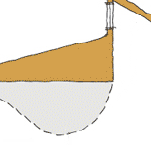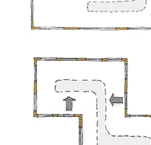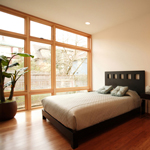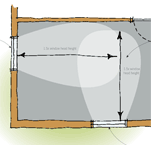Passive Design
Designing the building and the spaces within it to benefit from natural light, ventilation and even temperatures.
Daylighting
Daylight should be used as much as possible to light a home, both for energy efficiency and for the health and comfort of occupants.
On this page:
- Building Code requirements
- sources of daylight
- increasing daylight penetration
- improving interior lighting levels.
Ensure that daylight can penetrate fully into the building.
Design requirements for daylighting must be balanced with the client’s requirements for views and privacy. Daylighting must also be considered alongside building location, orientation and layout, in order to control solar access for passive heating and cooling.
Principles for utilising natural light include:
- use diffused light rather than direct sunlight, which requires careful placement and sizing of windows
- avoid over-glazing which may cause glare and heat gain in summer and heat loss in winter.
Building Code requirements
New Zealand Building Code clause G7 Natural light has the functional requirement:
- “Habitable spaces shall provide adequate openings for natural light and for a visual awareness of the outside environment.”
There are two performance requirements:
- “Natural light shall provide an illuminance of no less than 30 lux at floor level for 75 % of the standard year.
- Openings to give awareness of the outside shall be transparent and provided in suitable locations.”
Acceptable Solution G7/AS1 only applies to buildings up to 3 storeys such as detached buildings and attached side-by-side townhouses and specifically excludes those with internal rooms that rely on borrowed daylight. It requires:
- windows in external walls to have an area no less than 10% of the floor area
- a glazing light transmittance of no less than 0.7 (some commonly used glazing does not achieve this figure – for example, standard 5 mm grey tint has a light transmission of 0.5)
- windows to have a head height (the distance from the floor to the top of the window) of at least:
- half the room width where all the windows are in one wall or on adjacent walls
- one-quarter the width of the room where the windows are on opposite sides of the room.
In very large rooms this head height may not be practical and a window area in excess of 10% of floor area may be necessary.
Where the natural light coming through windows is reduced because of outside features such as other buildings nearby, the options are either to increase the total window area or provide more reflective interior surfaces.
To meet the G7 requirement for “awareness of the outside environment”, the Acceptable Solution states that at least 50% of the glazed area providing natural light in habitable spaces must be clear glass and must be between 900 mm and 2000 mm above floor level.
The Acceptable Solution G7/AS1 makes the comment: “Roof windows, skylights and/or clerestory windows could be added in excess of the required area of glazing.” In effect, this means that skylights cannot be used to demonstrate compliance with G7/AS1, so an Alternative Solution must be used if a portion of the required natural lighting is to be provided by skylights.
The Acceptable Solution G7/AS1 (2nd edition) only applies to simple buildings up to 3 storeys in low density developments. Acceptable Solution G2/AS2 has wider application, and G7/VM1 includes a computer modelling method.
Acceptable Solution G7/AS2 applies to simple buildings in low, medium and high-density developments, such as simple multi-unit apartment designs with vertical windows in external walls and excludes those with internal rooms that rely on borrowed daylight. It has slightly different requirements to G7/AS1. For example, while G7/AS1 requires an area of glazing with a visual light transmittance (VLT) of no less than 70%, G7/AS2 has provision for vertical windows with a glazing VLT between 40% and 80%.
Sources of daylight
Daylight inside a building comes from three sources:
- Direct sunlight provides both light and solar gain. If the sky is overcast, solar gain is reduced but the sky dome continues to be the source of daylight.
- External reflection comes from light reflecting from ground surfaces, adjacent buildings, wide window sills and light shelves. Excessive reflectance may cause glare and should be avoided.
- Internal reflection comes from light reflecting from the internal walls, ceiling and floor. High reflectance surfaces such as smooth or gloss surfaces, light-coloured finishes and mirrors reflect light around the room, increasing penetration and also reducing extremes in brightness contrast.
Increasing daylight penetration
The higher the window head, the deeper the daylight will penetrate into the interior. A window will produce useful illumination to a depth of approximately 1.5 times the window head height. Therefore, increasing the height of the window head can increase the depth of light penetration up to two times or more.
Other ways light can be allowed to penetrate into the building interior include:
- installing full-height windows with the head as high as possible (but ensure that the minimum distance between the head height and the underside of the overhang is maintained)
- using roof-lights for top lighting – insulating glass units (IGUs) must be used for roof glazing to minimise heat loss
- designing open plan spaces
- installing light shelves
- including high level, clerestory windows
- using glazed internal walls or borrowed lights
- installing lightpipes (proprietary tubular rooflights)
- designing so all spaces requiring daylighting have access to an external wall
- using glass that admits light but reduces glare and UV
- arranging spaces so natural lighting comes from two or more directions.
Improving interior lighting levels
Use reflective finishes such as light colours, gloss finishes and mirrors to increase the penetration of natural light into the interior. Reflectance values of light colours increase daylight penetration up 80% from ceilings, 50–70% from walls and 20–40% from floors. The reflectance value for white paint is approximately 75% when new but drops off as it discolours with age.
Window frames, jambs and sills should also be painted in light colours, and where windows are deep set, jambs should be splayed or angled towards the interior.
Although floors contribute the least reflectance, a dark-coloured floor finish will reduce the light levels in a room.

- Rooflights and clerestory windows improve daylight levels in deep rooms
Because daylight illumination falls off with distance from the windows, adding clerestories, roof-lights or borrowed lights can improve the level and distribution of daylight.

- Maximising daylight and ventilation
To ensure daylight reaches the back wall of a space, make sure the distance from window to wall is no more than 1.5-2 times the height at the top of the window.
Updated: 20 October 2023



